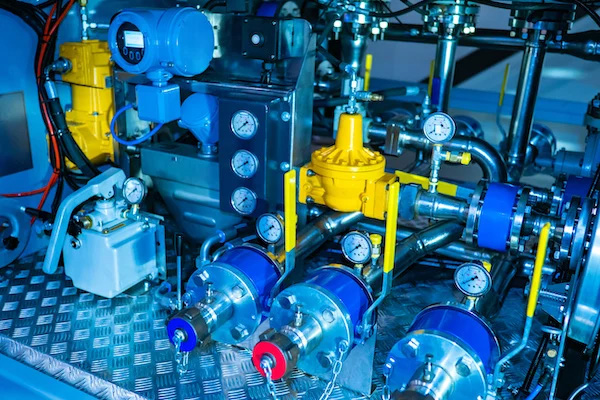Troubleshooting a hydraulic system involves more than running a pipe cleaner through a check valve. Like any good plan, it begins by diagnosing the system to identify trouble spots, then defining the course of action to ensure the equipment or machine will run efficiently. In the simplest cases, there may be a clogged filter that is causing the system to run hot. Checking the condition monitoring system will indicate which filter is clogged; then it can simply be replaced.
Unfortunately, it's not always that easy. Hydraulic fluid power systems perform work by utilizing pressurized fluids to move things, large and small. These objects can be critical, such as a utility bucket truck-- or something less critical, like a snowplow for the front of a pickup truck. Someone could get hurt if the hydraulics on the utility bucket fail. A small snowplow's cylinder could fail and you will likely just have a frustrated plow man. 
Maintenance engineers are often faced with issues related to flow, over or under pressure, excessive heat, vibration and leakage in industrial or heavy equipment applications. These problems can be caused by a variety of factors, typically from poorly seated hose fittings, a bad seal on a piston rod or clogged filters. Each results in leakage and ultimately a drop in pressure, or an overheated system caused by a clogged filter. However, the reason for pressure decreasing or the system overheating is not always readily known without thorough troubleshooting. This involves performing diagnostics to determine the best course of action to restore system pressure or reach the specified temperature range and bring the machine back online. A doctor wouldn't perform surgery if he didn't run tests first. Similarly, you don't replace every component in a hydraulic system until the pressure or temperature has been restored.
Troubleshooting a hydraulic system takes time and can be challenging. It requires considerable skill, experience and a lot of common sense. Maintenance engineers often try to use a quick fix to get the system back online because downtime is expensive. Instead, they should be thorough in diagnosing the problem. If they aren’t, the problem will likely reoccur.
It’s important to follow a systematic approach in taking the necessary steps to troubleshoot a hydraulic system.
- First, gather the facts of what’s occurring: is the hydraulic fluid overheating (above 180°F/82°C), are cycle times longer or is the system operating slower than normal?
Like your doctor asking where it hurts, technicians should start by asking the operators some key questions to narrow down the source of the problem. For instance:
- Did the system slow down? Where did it slow down?
- Is it a reoccurring problem? If so, how often?
- If it’s not consistently reoccurring, does it seem to be a one-off event, or does it happen at irregular sporadic intervals?
- Is a component vibrating or making an unusual sound?
- Is there a leak? If so, is it a lubricant or hydraulic fluid, and where is the leak occurring?
- Is there overheating? What appears to be the source?
- Was there a major pressure loss or pressure spike? And where in the system did it happen?
- Have there been any recent additions to the system, like a new control device or replacement of a valve?
- Did the system slow down? Where did it slow down?
- Even if an operator gives indications about what happened, it’s still necessary to review the manufacturer’s manual and hydraulic schematics to see if the problem identified by the user has resulted in additional downstream issues. The schematics will provide essential information about the system’s normal flow and pressure specification and help to confirm the source of the problem.
Though air and water contamination accounts for 80 to 90 percent of hydraulic failures, it is still necessary to review the system schematics to set a baseline for checking all potential component issues. System breaches like the ingress of particulates into components, faulty pumps or temperature issues are all common causes of contamination. - Some basic steps in troubleshooting include making sure the system pressures are properly set by checking:
- Accumulators
- Pressure-control valves
- Pressure-reducing valves
- Pump compensator
- Relief valves
- Accumulators
Once the problems are identified, make the necessary adjustments or replacement of components. If contamination is the problem, make sure to identify its source to eliminate the potential of recurrence.
When the system has been repaired and is ready to be brought back online, it is a good idea to first replace the fluid, especially if there were any contaminants.
Conclusion
First, gather information about the problem and then review the hydraulic schematics. Next, address the issues as cited by the operator, then run through temperature, contamination and any other tests that are applicable to the initial problem. Before you replace the fluid and restart the system, it’s best to run through diagnostics to troubleshoot the rest of the system. The initial problem could have led to another, and it’s better to make any additional adjustments while you’re already offline. If not, it will cost more in downtime if there is an undetected issue that causes problems later. Bringing a hydraulic system back online can be a time consuming process, yet correcting all potential issues upfront will save time and money.
And by the way, don’t run a pipe cleaner through a check valve.
To learn more about another essential component to hydraulic systems, check out our free BluPrint discussing hydraulic manifolds:
Sources Include:

